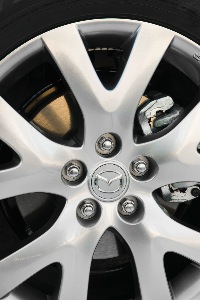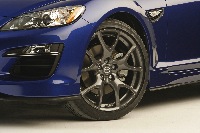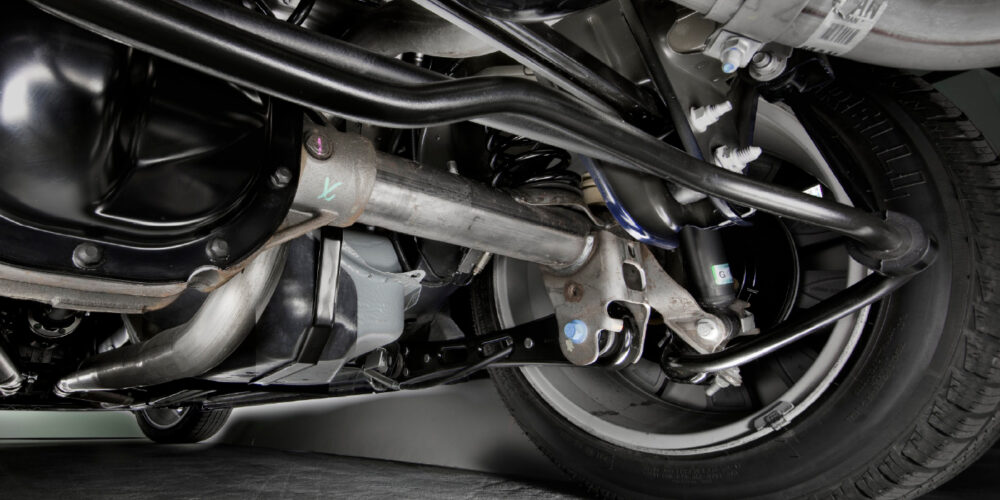
This month, we’ll take a look at brake and undercar service on the Mazda line of cars and light trucks. Since this work is a mainstay for many shops, the nuts and bolts of this type of work should be routine to all but the newest techs. With some of those folks cutting their teeth in the shop doing this kind of work, we’ll cover things that will help the rookies while reminding the more experienced techs of this fact: While brake and chassis work can become routine, good work habits are critical for a successful job from beginning to end.
Every job should start with the customer interview. When the appointment is made, it’s important that some questions that will help ensure a successful job get answered. The first question to ask is why the customer thinks the brakes need service. What is obvious to us is a mystery to the customer so it’s important that we establish what it is that has the customer concerned. There is nothing more disappointing to a customer than to spend money on a repair and not have their concerns addressed. And, with the brakes being the most important safety system in a vehicle, you don’t want folks driving for a week with the brakes metal to metal.

If you’re operating a successful shop, you are probably already focusing on preventive maintenance and all of your techs, as well your customers, are aware of the benefits of that practice. Your regular clients are expecting that the brakes will be at least visually inspected whenever the car is in for service and it’s up to you not to disappoint them.
Anticipating and pointing out service that will be needed in the future isn’t selling, as much as it is performing a valuable service. It is beneficial for both the shop and the customer to anticipate future services, allowing them to tie up the car when it’s convenient for them, while you keep the bays full with scheduled work.
Brake problems will present themselves in a couple of ways. The most common complaints are noise-related. Mazdas, like many other manufacturers, make use of the simple and effective tab-type sensor that will contact the rotor when the pads need to be replaced. The resulting, high-pitched squeaking noise has proven to be very effective in getting drivers’ attention. That’s not to say that drivers won’t ignore it and drive until the brakes are making that distinctive grinding noise that indicates the friction material is gone and metal-to-metal contact is taking place. Of course, in that case, the car should be parked until repairs are made.
Many of the occasional, annoying noises that disc brakes make are a small trade-off for the braking performance delivered by the system. Oftentimes, just explaining that to a customer goes a long way toward settling their concerns that something is wrong with his/her brakes.
But, any noise that is more than occasional should be investigated. Some noise will be the result of rust on the rotors, calipers, hardware or even the brake pads themselves. Use only the best parts, replace questionable units and make sure that the brake hardware is in good condition or new. This is particularly important with Mazda 3s and 6s that have some problems with the hardware contacting the rotors. There have been some tech bulletins related to this issue so be sure to check your service info. Also make sure that all the metal-to-metal contact areas are lubed with the proper grease that’s designed to do this tough job in a harsh environment.
FIRST THINGS FIRST
The first step in any brake inspection should be a test drive, as it’s always a good idea to confirm the customer’s complaint. The test drive will also let you note any other issues with the car that should be addressed while the brake service is being performed.
Again, on the Mazda 3s, wheel bearing failures are fairly common and the noise will come on gradually and is often overlooked by the customer. If you’re going to have the brakes apart, this is the time to take care of the wheel bearings. The same can be said for sway bar links. Oftentimes, just letting the customer know that the cause of that banging noise can be taken care of at a reasonable cost will motivate the repair. I think we all agree that it’s more efficient to know the noise is there before the car is on the lift. Of course, you will also be looking for rotor vibration/pulsation, a long pedal or pulling that would be directly related to the brake system.
The inspection continues back at the shop and on the lift. It shouldn’t take long to establish that the vehicle needs brake service, but before you call to get authorization from the customer, spend a few minutes so you can provide an accurate estimate. I’ve never had a customer who enjoys getting that surprise phone call that more problems have been found.
Spin and shake the wheels before they come off. Any excessive drag should be noted and, it goes without saying, that any looseness in the steering should be investigated and reported. The same goes for cracked CV boots or leaking struts. With the wheels off, it doesn’t take long to get a good look at the pads and rotors. Read them for additional information, and look for signs of overheating or uneven wear indicating a sticking caliper or pads.
Leaking calipers or wheel cylinders always leave visual evidence, so inspect the brake hoses and if they need to be replaced, now is the time to take care of it. If you suspect a sticking caliper, take the time to confirm it. Pads that are seized in the brackets or frozen sliders will mimic a bad caliper, even though hydraulically the caliper is fine.
After the car has been inspected and the job has been sold, it’s time to get to work. As I mentioned earlier, brake work is routine for the most part for most of us, but it’s important that solid work habits are used from the beginning to the end of the job. Be sure to open the bleeder valves before the pistons are pushed backed into the caliper.
With most cars today being equipped with ABS, there is little tolerance for contaminated fluid being pushed back through the system and that sensitive modulator unit. You are going to be bleeding and flushing the system as part of the service, so there is no time lost in this step. And, if the bleeder can’t be opened or needs to be cleaned, it’s better to find out now rather than after the caliper has been serviced and new pads have been installed.
VIBRATION/ROTOR ISSUES
The most common brake-related vibration is that which occurs while braking and is caused by disc thickness variation. Ask your customer some questions that could help ensure a quality job. When did you notice the problem, and was there any action that led to the problem? Did you have any tire work done lately? If so, it’s likely you’ll find that the lug nuts are unevenly tightened. To confirm this condition, loosen the lug nuts by hand. More often than not, the overtightened nuts will be obvious.
The biggest enemy of the rotor is heat. The rotor has a tough job on a system that’s in good shape, but it doesn’t have a chance on a system that has excessive, heat-causing drag. Take a good look at the rotors as they’re removed for signs of overheating. It makes little sense to install fresh parts only to subject them to the same conditions. It could be that the last tech who did the brakes didn’t get the caliper brackets clean or missed a point that should have been lubed. More likely, the increased mileage has caused a problem. Either way, if it’s not corrected, your new rotors will soon be in the same shape as the ones you just took off.
This leads us to more discussion on work habits. Be certain that all the areas where pad movement takes place are cleaned and lubed. Don’t overlook the area under the tin pad brackets; rust buildup here will result in tight-fitting pads. Also be sure the caliper slides are inspected, clean and lubed. This is important not only for smooth, quiet brake operation, but it is critical for the ABS to operate as expected.
Being located in the Northeast, we see firsthand how the harsh environment can be on the brake system. In extreme cases, you may find that it’s more cost effective to replace the calipers rather than spend the time required servicing the originals.
With high-mileage vehicles, you could be faced with a “brake pedal sometimes fades to the floor” complaint. Although it’s not a common complaint on Mazdas, a little detective work is required in such cases. If the pedal fades as the vehicle comes to a stop, often in a situation where the pedal is being partially applied in anticipation of coming to a full stop, it’s a safe bet the master cylinder is the culprit.
If, on the other hand, the condition results from a long ride at highway speeds, it’s likely that excessive drag is causing the fluid in the calipers to overheat, resulting in brake fade. When the brakes cool, the pedal often will return to what feels like normal to the customer. Many times, the customer will report a burning smell and, in the worse cases, will cause a severe vibration. It takes a stuck caliper to generate the degree of heat needed to cause these problems, and they certainly should be checked closely.
You should be able to find the problem wheels by inspecting the rotors. If that much heat was generated, the calipers, as well as the rotors, will show the signs. If you can duplicate the tight wheel, don’t be too quick to condemn the caliper without cracking open the bleeder to be sure there’s no pressure in the line.
If pressure exists, backtrack through the hydraulic system until the restriction is found. It could be a collapsed brake hose acting as a one-way valve, or you may work your way back to a contaminated ABS modulator. It’s always a good practice to replace any brake hose that was subjected to extreme heat, even though it may look OK and not leak. There is no way to know if the integrity of the crimps were comprised, so for a few dollars it’s better to be safe than sorry.
Mazda uses a hand-brake that is incorporated into the rear caliper. They use a couple of systems to retract rear pistons. The later-model cars require the familiar method of turning the piston clockwise while applying pressure, where others will have a plug on the back side of the caliper that provides access for an Allen wrench to facilitate retracting the piston, but be careful as you retract the piston.
As always, it never hurts to check your service information. We know everyone doesn’t use his or her hand-brake on a regular basis, and we also know that a mechanical device doesn’t like to sit around not being used, only to suddenly be forced into service. The same thing can be said for the cables. If the hand-brake levers aren’t returning on the caliper, be sure that the cables aren’t binding. The complexity of the hand-brake does make the rear calipers a little pricier, but I still like to replace them in pairs to maintain the balance of the brake system.
Finish off with a good bleed and flush of the hydraulic system, torque the wheels and the car should give the customer many miles of trouble-free braking.
When it comes to the ABS system, Mazdas have proven to be very reliable. But that’s not to say they never have a problem. Codes can be retrieved on the early model cars by grounding terminal 13 in the datalink -1 connector that can be found under the hood. Install the jumper with key off, and when you turn the key on, the ABS lamp will be lit for three seconds before you get the familiar flash codes — with the long flashes representing tens and the shorts being ones. For example, one long flash followed by a short flash represents a code 11 for a right front speed sensor circuit problem.
To clear the code, go through the same procedure waiting for the codes to be displayed. When the first code is displayed a second time, hit the brakes 10 times at one-second intervals. If the code won’t clear, be sure the brake light switch is working as expected. Be aware that if the repair involved a wheel speed sensor or control unit repair, the light will stay illuminated until the car is driven over six miles per hour.
With 2004 and newer models, you’ll need a scanner with the capability of accessing the ABS system to retrieve codes. Hopefully by now, your shop has made the investment in the necessary equipment, as there are plenty of affordable options available and it’s simply foolish at this point to try and get by without the necessary tools.
As I mentioned earlier, we have been seeing some wheel bearing failures on the popular Mazda 3 models. The nuts and bolts of the replacement procedure shouldn’t present a challenge for most techs, but it’s important to keep in mind that the bearings are directional and have to be installed with the internal tone ring facing the ABS sensor.
Most bearings are colored-coded with the green seal being installed toward the sensor. Since the tone ring is magnetic, you can confirm the proper direction by laying a clean piece of paper on the bearing and sprinkling some shavings from the brake lathe on the paper. It will be easy to tell which side is magnetic and, needless to say, it’s critical that the shavings do not find their way into the bearing.













